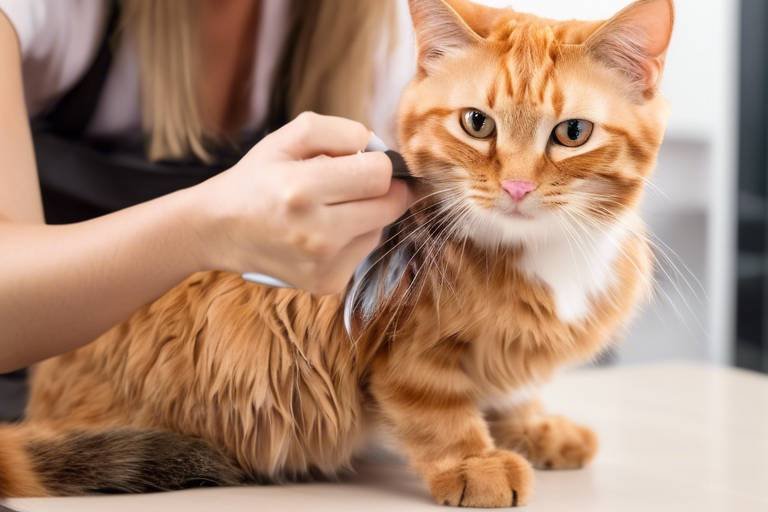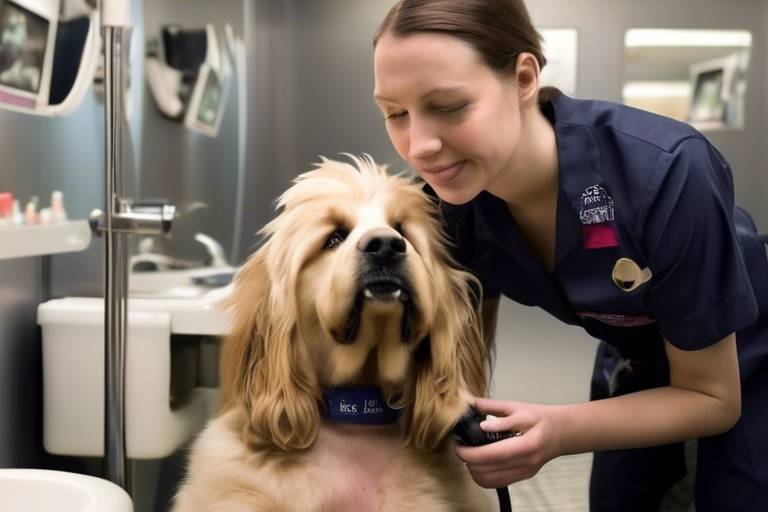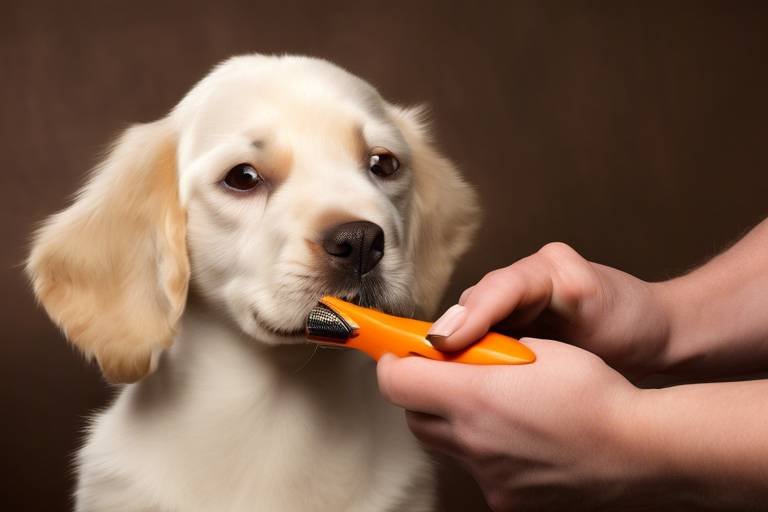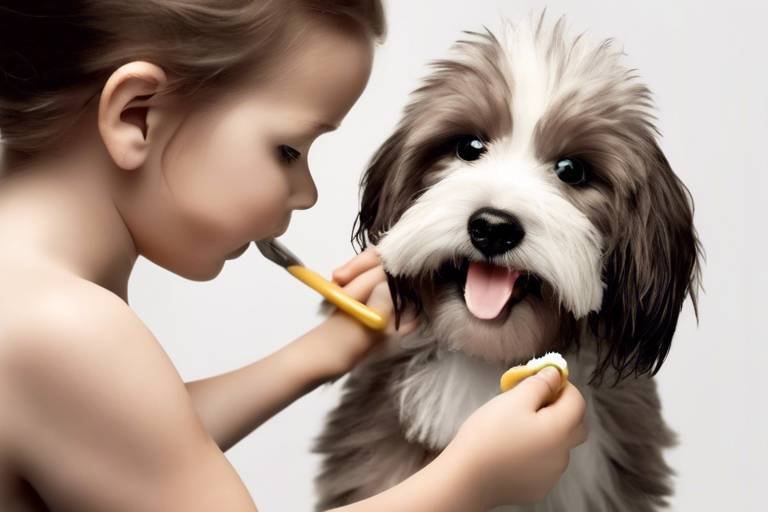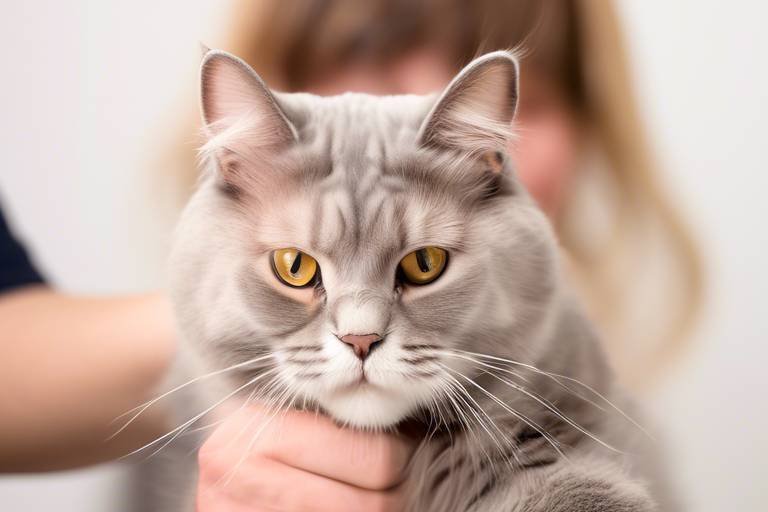The Benefits of Regular Grooming for Cats
Grooming your cat might seem like just another chore on your to-do list, but it’s so much more than that! Think of grooming as a special time you get to spend with your furry friend, enhancing both their health and your bond. Regular grooming isn’t just about keeping your cat looking fabulous; it plays a crucial role in their overall well-being. From preventing health issues to reducing shedding and allergens in your home, the benefits are vast and impactful. So, let’s dive into the world of cat grooming and uncover why it’s essential for every feline owner!
First and foremost, regular grooming helps maintain your cat's health by preventing matting, reducing shedding, and minimizing skin issues. Imagine your cat’s fur as a beautiful, flowing river; if it gets clogged with debris and knots, it can’t flow freely. Regular brushing helps keep that river clean and clear. Plus, grooming sessions provide an excellent opportunity for early detection of health problems. You might notice lumps, bumps, or skin irritations that could require veterinary attention. Catching these issues early can lead to more effective treatment, ensuring your feline friend stays happy and healthy!
Did you know that grooming can be a fantastic way to bond with your cat? Just like how a mother cat licks her kittens to comfort them, your grooming sessions can enhance trust and affection between you and your pet. This shared experience can lead to a happier and more secure cat. Think of it as a mini spa day for your feline; they’ll appreciate the attention, and you’ll enjoy the time spent together. It’s a win-win situation!
Consistent grooming helps your cat feel more comfortable with handling. Imagine if you were taken to a place you didn’t know, and someone was trying to hold you down without any explanation. You’d feel anxious, right? The same goes for your cat. When you regularly groom them, they learn to trust you, making future veterinary visits and daily interactions much easier for both of you. This trust is essential for a smooth relationship, so don’t underestimate the power of a good brush!
Using gentle grooming techniques can make the experience enjoyable for your cat. It’s important to understand their preferences and use the right tools. For instance, some cats love a soft brush, while others might prefer a comb. Pay attention to their reactions; if they purr and lean into the brush, you’re on the right track! Creating a positive environment during grooming sessions will ensure that your cat looks forward to them instead of dreading them.
Being aware of your cat's body language during grooming is crucial. Cats communicate a lot through their body language, and recognizing signs of stress can help you adjust your approach. If your cat starts to twitch their tail, flatten their ears, or try to escape, it might be time to take a break. This awareness allows you to create a more relaxed experience for your feline, ensuring they feel safe and comfortable during grooming.
Establishing a regular grooming routine can make the process smoother and more enjoyable for both you and your cat. Consistency helps your pet anticipate grooming sessions, which reduces anxiety. Just like how you might look forward to your weekly movie night, your cat can learn to enjoy grooming time. Try to set aside a specific time each week for grooming, and stick to it. Over time, your cat will adapt and may even start seeking out those grooming sessions!
One of the most significant advantages of regular grooming is the reduction of shedding. This not only keeps your home cleaner but also minimizes allergens in your living space. If you or someone in your home suffers from allergies, you’ll appreciate how less fur floating around can make a difference. Regular brushing removes loose fur, which means less cleaning for you and a healthier environment for everyone!
Selecting appropriate grooming tools for your cat's fur type is crucial. Different brushes and combs serve various purposes, ensuring effective grooming while keeping your cat comfortable. For example, long-haired cats might benefit from a slicker brush, while short-haired cats can thrive with a rubber grooming mitt. Understanding what works best for your cat will make grooming a breeze and keep their coat looking shiny and healthy!
Cats have different grooming needs depending on the season. In the warmer months, they may shed more, requiring more frequent brushing. Conversely, during winter, their coats may become thicker, necessitating different grooming approaches. Understanding these seasonal changes can help you adjust your grooming routine to maintain your cat's coat and overall health effectively. Keep an eye on your cat’s fur and adjust your tools and techniques accordingly!
- How often should I groom my cat? It depends on the breed and coat type. Long-haired cats may require grooming several times a week, while short-haired cats can be groomed less frequently.
- What tools do I need for grooming? Basic tools include brushes, combs, and nail clippers. Choose tools that suit your cat's coat type for the best results.
- Can grooming help with shedding? Absolutely! Regular grooming removes loose fur and minimizes shedding, keeping your home cleaner.
- What if my cat doesn’t like grooming? Start slowly and use gentle techniques. Create a positive environment and reward your cat with treats to help them associate grooming with good experiences.

Improved Health and Hygiene
Regular grooming is not just about keeping your cat looking fabulous; it’s a vital part of maintaining their overall health and hygiene. Think of grooming as a health check-up that you can do right at home! By brushing your cat's fur, you help to prevent matting, which can lead to painful skin irritations. Imagine having tangled hair that pulls at your scalp; that’s how your cat feels with matted fur. By keeping their coat smooth and free of knots, you’re ensuring that their skin can breathe and stay healthy.
Moreover, regular grooming significantly reduces shedding. If you’ve ever noticed a fur tornado swirling around your living room, you know how important it is to manage shedding. When you groom your cat, you’re not only collecting loose fur but also minimizing the amount that ends up on your furniture and clothing. This is particularly beneficial for those who suffer from allergies, as less fur in the environment means fewer allergens floating around. In fact, regular grooming can help create a more comfortable living space for everyone in the household.
Another critical aspect of grooming is the early detection of health issues. While brushing your cat, you might come across unusual lumps, bumps, or skin irritations that could indicate a health problem. For instance, if you notice any changes in your cat's skin or coat texture, it could be a sign of underlying health issues that require veterinary attention. Being proactive about grooming means you can catch potential problems early, leading to timely and effective treatment. It’s like having a personal detective on the case of your cat’s health!
To illustrate the importance of grooming in maintaining health and hygiene, consider the following table:
| Grooming Benefit | Description |
|---|---|
| Prevents Matting | Regular brushing keeps the fur untangled, preventing painful knots. |
| Reduces Shedding | Less loose fur in your home means fewer allergens and a cleaner environment. |
| Early Health Detection | Regular grooming allows you to spot potential health issues before they escalate. |
In conclusion, grooming your cat is a multi-faceted approach to ensuring their health and hygiene. It’s not just about aesthetics; it’s about creating a happy and healthy feline companion. So, grab that brush and make grooming a regular part of your cat’s life. Your furry friend will thank you for it!

Bonding Time with Your Cat
Grooming your cat is not just about keeping their fur looking fabulous; it’s also a fantastic way to strengthen the bond between you and your feline friend. Imagine this: you’re sitting together, gently brushing their coat, and in that moment, you’re not just removing loose hair—you're building a connection that transcends words. Cats are creatures of habit, and when you incorporate regular grooming into your routine, it becomes a shared ritual that fosters trust and affection.
Think of grooming sessions as mini spa days for your cat. They get to enjoy the soothing sensation of a brush gliding through their fur while you get to witness their contentment. This shared experience is crucial because it helps your cat associate you with positive feelings. Over time, as you both settle into this routine, you’ll notice that your cat becomes more relaxed and trusting during these sessions. This trust is invaluable, especially when it comes to veterinary visits or other situations that may require handling.
But how do you ensure that these grooming sessions are enjoyable? It all starts with gentle techniques. Using the right tools and understanding your cat’s preferences can make a world of difference. If your cat enjoys being brushed, they’ll likely purr and nuzzle against you, which is a clear sign that they appreciate your efforts. On the flip side, if they seem agitated or try to escape, it’s essential to take a step back and reassess your approach.
Recognizing your cat’s body language is key. Are their ears back? Is their tail twitching? These are signs that your kitty might be feeling stressed. By being attentive to these signals, you can adjust your grooming techniques accordingly. Maybe it’s time for a break or a change in the grooming tool. The goal here is to create a positive environment where your cat feels safe and cared for.
Establishing a consistent grooming routine can also help your cat anticipate these sessions, reducing anxiety. Just like humans, cats thrive on predictability. By grooming them at the same time each week, you’re not only keeping their coat in check but also helping them feel more secure in their environment. This routine can be as simple as a quick brush every Sunday afternoon or a more elaborate grooming session once a month. Whatever works for you and your cat is what matters most!
In summary, grooming is much more than a chore; it’s an opportunity to deepen the bond with your cat. By creating a relaxing environment, recognizing their comfort levels, and establishing a routine, you can transform grooming into a cherished time for both of you. So the next time you pick up that brush, remember: you’re not just grooming; you’re building a lifelong friendship.
- How often should I groom my cat? It depends on the breed and coat type, but generally, long-haired cats require grooming at least 2-3 times a week, while short-haired cats may only need it once a week.
- What tools do I need for grooming? Common grooming tools include a slicker brush, a comb, and nail clippers. Choose the right ones based on your cat's fur type.
- Can grooming help with shedding? Yes! Regular grooming helps to remove loose fur and reduces shedding, which can help keep your home cleaner.
- What if my cat hates being groomed? Start slowly and use treats to create a positive association. Gradually increase grooming time as they become more comfortable.
Building Trust Through Grooming
Grooming your cat isn't just about keeping their fur looking fabulous; it's also a fantastic way to build a deeper bond with your furry friend. Think of grooming as a shared ritual, much like a mother bird preening her chicks. When you take the time to groom your cat, you're not just removing tangles and dirt; you're also sending a message that you care. This can significantly enhance the trust your cat has in you. Trust is vital in any relationship, and with our feline companions, it can make a world of difference in their comfort level during various activities, including vet visits.
When you consistently groom your cat, you help them feel more at ease with being handled. It's like giving them a gentle reminder that they are safe and loved. This kind of positive reinforcement can lead to a more relaxed and affectionate pet. Imagine how much easier it will be for your cat to accept a trip to the vet if they associate being touched and handled with something enjoyable, like grooming sessions. So, how can you make grooming a positive experience? Here are some gentle techniques to consider:
- Start Slow: Begin with short sessions to help your cat get used to the process.
- Use the Right Tools: Choose brushes and combs that are suitable for your cat's fur type.
- Watch for Signs of Comfort: Pay attention to your cat’s body language; if they seem relaxed, you’re on the right track!
As you build this trust through grooming, it’s essential to recognize the signs of stress that your cat may exhibit. Cats can be quite vocal about their discomfort, and being aware of their body language can help you adjust your approach. If your cat flattens their ears or swats at the brush, it’s a clear indication that you should take a step back and reassess. By tuning in to your cat’s feelings, you can create a more enjoyable grooming experience, reinforcing the trust you’re working to build.
In conclusion, grooming is not just a chore; it’s an opportunity to foster a loving relationship with your cat. By being patient and attentive, you can transform grooming sessions into a time of bonding and trust-building, making both you and your feline friend happier in the long run. Remember, every little effort counts, and the more trust you build, the more enjoyable those grooming sessions will be!
Q1: How often should I groom my cat?
A: It depends on the breed and coat type. Long-haired cats may need grooming several times a week, while short-haired cats can be groomed less frequently.
Q2: What tools do I need for grooming?
A: Basic grooming tools include a brush, comb, and nail clippers. Choose tools that are appropriate for your cat's fur type.
Q3: What if my cat doesn't like being groomed?
A: Start with short grooming sessions and gradually increase the time. Use treats and praise to create a positive association with grooming.
Q4: Can grooming help with shedding?
A: Yes! Regular grooming helps remove loose fur and reduces shedding, which can also minimize allergens in your home.
Gentle Techniques for Comfort
When it comes to grooming your cat, the approach you take can make all the difference in creating a positive experience. Gentle techniques not only ensure your feline friend feels comfortable but also foster a sense of trust between you two. Imagine being pampered at a spa; that's how your cat should feel during grooming sessions! Start by using soft brushes that glide smoothly over their fur. Cats are sensitive creatures, and a rough touch can lead to anxiety and resistance. Instead of rushing the process, take your time and let your cat acclimate to the sensation of the brush. This way, grooming transforms from a chore into a delightful bonding moment.
Additionally, it’s essential to consider the timing of your grooming sessions. Choose moments when your cat is relaxed, perhaps after a meal or a good play session. This timing can significantly reduce their stress levels. You might also want to incorporate soft, soothing voices and gentle petting before you start grooming. These actions can create a calming atmosphere, allowing your cat to feel safe and cherished. Remember, the goal is to make grooming a pleasant experience rather than a dreaded task.
Another effective technique is to break the grooming into short sessions. Instead of trying to do everything in one go, focus on one area at a time. For instance, you could start with brushing their back, then take a break, and later work on their paws. This method not only keeps your cat engaged but also helps them gradually get used to the entire grooming process. If they seem to enjoy a particular area being groomed, feel free to linger there a bit longer. This positive reinforcement encourages them to look forward to future grooming sessions.
Lastly, always be observant of your cat’s body language. Cats communicate a lot through their posture and movements. If you notice signs of discomfort, such as tail flicking or attempts to escape, it’s crucial to pause and reassess. Adjusting your technique or taking a break can help maintain a stress-free environment. By being attentive to your cat's needs and preferences, you can create a grooming experience that is not only effective but also enjoyable for both of you.
Q: How often should I groom my cat?
A: It depends on your cat's breed and fur type. Long-haired cats may need grooming several times a week, while short-haired cats can often be groomed less frequently, perhaps once a week.
Q: What tools should I use for grooming?
A: The right tools depend on your cat's fur type. For example, slicker brushes are great for long-haired cats, while rubber brushes can help remove loose fur from short-haired breeds.
Q: Can I use human grooming tools on my cat?
A: It's best to use tools specifically designed for cats. Human brushes may be too harsh and could cause discomfort or skin irritation.
Q: What if my cat doesn't like being groomed?
A: Start slowly and gradually introduce grooming. Use treats and praise to create a positive association. If your cat continues to resist, consider consulting a professional groomer or veterinarian for advice.
Recognizing Stress Signals
When it comes to grooming your beloved feline, understanding their body language is essential. Cats are masters at concealing their feelings, but there are subtle cues that can indicate stress or discomfort during grooming sessions. For instance, if your cat suddenly becomes rigid or starts to twitch their tail, it might be a sign that they are feeling uneasy. Additionally, if they attempt to escape or hide, it’s crucial to recognize these behaviors as signals to pause and reassess the situation.
Another common stress signal is excessive grooming or licking. If your cat starts to groom themselves obsessively, it could be a way of coping with anxiety. Similarly, if they vocalize more than usual, such as hissing or growling, it’s a clear indication that they’re not enjoying the experience. Remember, your cat's comfort should always come first, so being attuned to these signs can make a world of difference.
Here are some additional stress signals to keep an eye out for:
- Flattened Ears: Ears that are pinned back against the head often indicate fear or irritation.
- Dilated Pupils: If your cat’s pupils are larger than normal, it can be a sign of stress or excitement.
- Quick Movements: Sudden jerks or quick movements away from you can signal discomfort.
- Swatting or Biting: If your cat swats at you or tries to bite, it’s a clear sign they’ve had enough.
By recognizing these stress signals, you can create a more positive grooming experience for your cat. Adjusting your approach—like taking breaks, using softer brushes, or even changing the grooming environment—can help alleviate their anxiety. Remember, the goal is to make grooming a pleasant bonding experience, not a stressful chore.
Q: How often should I groom my cat?
A: The frequency of grooming depends on your cat's fur type. Long-haired cats may require grooming several times a week, while short-haired cats might only need it once a week.
Q: What tools should I use for grooming?
A: The right tools depend on your cat's coat type. A slicker brush works well for long-haired cats, while a rubber brush can be effective for short-haired breeds.
Q: What if my cat hates being groomed?
A: Start slowly and use treats to create a positive association. Gradually increase the grooming time as your cat becomes more comfortable.
Q: Can grooming help with shedding?
A: Yes! Regular grooming helps remove loose fur and reduces shedding, which is especially beneficial during shedding seasons.
Creating a Routine
Establishing a regular grooming routine for your cat is like creating a comforting ritual that both you and your feline friend can look forward to. Just think about it: when you wake up every day at the same time, your body naturally adjusts to that rhythm, making mornings smoother and more enjoyable. The same principle applies to grooming! By setting aside specific times for grooming, you help your cat anticipate these sessions, which can significantly reduce any anxiety they might feel.
Start by choosing a consistent time during the week that works for both you and your cat. Whether it’s every Saturday morning or a quick session every evening, consistency is key. You might even want to keep a little grooming calendar to track your sessions and note how your cat responds. This can help you identify patterns in their behavior and preferences, allowing you to tailor the experience to their needs.
Additionally, consider the length of each grooming session. For some cats, a quick five-minute brush may suffice, while others may enjoy a longer, more thorough grooming experience. Pay attention to your cat's cues; if they seem to enjoy the process, feel free to extend the session, but if they show signs of stress, it might be best to wrap it up early. Remember, the goal is to make grooming a positive experience!
Incorporating treats or playtime before and after grooming can also enhance the experience. By associating grooming with positive outcomes, you’re more likely to create a routine that your cat looks forward to. You might say, “Hey, let’s have a little fun with the brush and then enjoy some tasty treats!” This approach not only reinforces good behavior but also strengthens the bond between you and your furry companion.
Lastly, don’t forget to adapt your routine as your cat ages or if their health changes. Older cats may require gentler grooming techniques or shorter sessions, while kittens might need more frequent grooming to get them used to the process. Being flexible and observant will help you maintain a successful grooming routine that evolves with your cat's needs.
- How often should I groom my cat?
It depends on the breed and coat type. Long-haired cats may need daily grooming, while short-haired cats might require it once a week. - What tools do I need for grooming?
Common grooming tools include brushes, combs, and nail clippers. Choose tools that are appropriate for your cat's fur type. - What if my cat doesn't like grooming?
Start slow and use treats to create positive associations. If your cat shows signs of stress, take a break and try again later. - Can grooming help with shedding?
Absolutely! Regular grooming helps reduce shedding by removing loose fur and preventing matting.

Reducing Shedding and Allergens
Regular grooming is not just about keeping your cat looking fabulous; it plays a vital role in reducing shedding and minimizing allergens in your home. If you've ever found cat hair on your favorite sweater or noticed that your allergies flare up when your furry friend is nearby, you're not alone! Shedding is a natural process for cats, but with consistent grooming, you can significantly decrease the amount of fur that ends up on your furniture and clothes.
When you groom your cat, you're not only removing loose hair but also helping to distribute natural oils throughout their coat. This contributes to a healthier, shinier fur while preventing mats and tangles that can trap even more hair. Regular brushing can capture up to 90% of loose fur before it falls out, which is a game-changer for maintaining a clean home.
Moreover, less shedding means fewer allergens floating around. Cat dander—tiny flecks of skin shed by cats—can be a significant trigger for allergy sufferers. By grooming your cat regularly, you help control the amount of dander released into the air. This is especially beneficial for those who are sensitive to allergens. In fact, studies have shown that households with regularly groomed pets experience a noticeable reduction in allergy symptoms.
But how often should you groom your cat? The answer depends on the type of fur your cat has:
| Fur Type | Grooming Frequency |
|---|---|
| Short-haired | Once a week |
| Medium-haired | Every 2-3 days |
| Long-haired | Daily |
By sticking to a regular grooming schedule, you can help maintain your cat's coat and reduce the amount of fur and dander in your home. Remember, the right tools make all the difference. A good brush designed for your cat's specific fur type will make the process easier and more effective. For example, a slicker brush works wonders for long-haired cats, while a rubber brush can be great for short-haired breeds.
In addition to grooming, keeping your home clean is essential for managing allergens. Regular vacuuming, using air purifiers, and washing your cat's bedding can all contribute to a healthier living environment. With these combined efforts, you can enjoy the companionship of your feline friend without the worry of excessive shedding and allergens.
- How often should I groom my cat? It depends on their fur type. Short-haired cats can be groomed weekly, while long-haired cats may need daily grooming.
- What tools should I use for grooming? Use brushes suited for your cat's fur type—slicker brushes for long-haired cats and rubber brushes for short-haired cats.
- Can grooming help with my allergies? Yes! Regular grooming can significantly reduce shedding and dander, which can help alleviate allergy symptoms.
Choosing the Right Tools
When it comes to grooming your feline friend, selecting the right tools is absolutely crucial. Just like a painter chooses the right brush to create a masterpiece, you need to pick the proper grooming tools to keep your cat's coat healthy and shiny. Not all cats are the same, and their grooming needs can vary widely based on their fur type, age, and even personality. So, how do you navigate this sea of options?
First off, consider your cat's fur type. Long-haired cats, such as Persians or Maine Coons, require different tools compared to short-haired breeds like Siamese or British Shorthairs. For long-haired cats, a wide-toothed comb and a slicker brush are your best friends. The wide-toothed comb helps detangle any knots without pulling on the skin, while the slicker brush removes loose fur and prevents matting.
On the other hand, short-haired cats benefit from a rubber grooming mitt or a bristle brush. These tools are great for removing loose hair and distributing natural oils throughout their coat, keeping it smooth and shiny. The key here is to understand that different tools serve different purposes, and using the right one can make the grooming experience much more enjoyable for both you and your pet.
Additionally, consider the comfort and safety of your cat during grooming sessions. Some cats can be sensitive to certain materials or brush types. Look for tools with soft bristles or rounded edges to ensure a gentle grooming experience. You want your cat to feel relaxed and happy, not anxious or scared. If your cat is particularly skittish, you might want to introduce grooming tools gradually, allowing them to sniff and explore before you start the actual grooming. This can help them associate grooming with positive experiences.
Another factor to keep in mind is the frequency of grooming. If you have a cat that sheds heavily, investing in a high-quality de-shedding tool can be a game-changer. These tools are designed to reach through the topcoat to remove loose undercoat fur, significantly reducing shedding and allergens in your home. A grooming schedule can be established based on the type of cat you have:
| Cat Type | Recommended Tools | Grooming Frequency |
|---|---|---|
| Long-haired | Wide-toothed comb, slicker brush | 2-3 times a week |
| Short-haired | Rubber grooming mitt, bristle brush | Once a week |
| Heavy shedders | De-shedding tool | Weekly |
In conclusion, choosing the right grooming tools is all about understanding your cat's unique needs. By selecting appropriate tools, you can make grooming a pleasant experience that not only keeps your cat looking great but also strengthens your bond. So, the next time you prepare for a grooming session, remember: the right tools can make all the difference!
- How often should I groom my cat? It varies by fur type; long-haired cats need grooming 2-3 times a week, while short-haired cats can be groomed once a week.
- What tools do I need for a long-haired cat? A wide-toothed comb and a slicker brush are essential for detangling and preventing matting.
- Can grooming help reduce allergens? Yes, regular grooming can significantly decrease shedding and dander, making your home more comfortable for allergy sufferers.
- How can I make grooming more enjoyable for my cat? Use gentle techniques, introduce grooming tools gradually, and provide treats and praise during and after grooming sessions.
Seasonal Grooming Needs
As the seasons change, so do your cat's grooming needs. Just like how we swap out our wardrobe for warmer or cooler clothes, your feline friend requires different grooming techniques and tools throughout the year. In the spring, for instance, cats tend to shed their winter coats, making it essential to brush them more frequently. This not only helps manage the excess fur but also prevents hairballs, which can be quite uncomfortable for your pet. You might notice that your cat’s coat becomes thicker in the winter, providing them with extra insulation against the cold. During this time, regular grooming helps distribute natural oils, keeping their fur healthy and shiny.
Additionally, summer brings its own set of challenges. Cats can suffer from overheating, especially long-haired breeds. Regular grooming sessions during this period can help keep their coat lighter and more breathable. It's also a great time to check for any signs of skin irritations or parasites, such as fleas and ticks, which tend to be more prevalent in warmer months. By being proactive about grooming, you not only enhance your cat's comfort but also ensure their overall health.
To make things easier, consider the following seasonal grooming tips:
- Spring: Increase brushing frequency to manage shedding and prevent hairballs.
- Summer: Use lightweight brushes and check for parasites regularly.
- Fall: Prepare for winter by ensuring their coat is healthy and well-groomed.
- Winter: Focus on maintaining coat health to provide insulation and warmth.
Understanding these seasonal variations not only helps you keep your cat looking fabulous but also contributes to their overall well-being. By adapting your grooming routine to the changing seasons, you can ensure that your furry friend remains happy, healthy, and comfortable all year round.
Q: How often should I groom my cat?
A: The frequency of grooming depends on your cat’s breed and coat type. Long-haired cats may require daily grooming, while short-haired cats can typically be groomed weekly.
Q: What tools do I need for grooming?
A: The right tools can vary, but common options include brushes, combs, and grooming gloves. Always choose tools that suit your cat's specific coat type for the best results.
Q: How can I tell if my cat is stressed during grooming?
A: Watch for signs like flattened ears, twitching tails, or attempts to escape. If you notice these signals, take a break and try again later.
Q: Can grooming help with allergies in my home?
A: Yes! Regular grooming reduces shedding and dander, which can help minimize allergens in your living space, making it more comfortable for allergy sufferers.
Frequently Asked Questions
- Why is regular grooming important for my cat?
Regular grooming is essential for your cat's health and hygiene. It helps prevent matting, reduces shedding, and minimizes skin issues. Plus, it allows for early detection of any health problems, ensuring you can seek veterinary care before things escalate.
- How can grooming strengthen the bond between me and my cat?
Grooming sessions are a fantastic way to bond with your cat. These moments of shared experience foster trust and affection, making your pet feel more secure and loved. It's like a mini spa day that brings you closer together!
- What are some gentle grooming techniques I can use?
Using gentle grooming techniques is key to making the experience enjoyable for your cat. Start with soft brushes and be mindful of their comfort level. Pay attention to their body language to ensure they’re relaxed, and always reward them with treats or affection afterward!
- How can I tell if my cat is stressed during grooming?
Being aware of your cat's body language is crucial. Signs of stress can include flattened ears, twitching tails, or attempts to escape. If you notice these signals, take a break or adjust your approach to create a more comfortable environment.
- How often should I groom my cat?
The frequency of grooming depends on your cat's coat type. Long-haired cats may require grooming several times a week, while short-haired cats might only need it once a week. Establishing a routine helps your cat anticipate grooming sessions and reduces anxiety.
- What tools should I use for grooming?
Selecting the right grooming tools is vital. Different brushes and combs serve various purposes, so consider your cat's fur type. For instance, a slicker brush works well for long-haired breeds, while a bristle brush is great for short-haired cats.
- Are there seasonal grooming needs I should be aware of?
Absolutely! Cats have different grooming needs depending on the season. In spring and summer, they may shed more, requiring more frequent grooming to keep their coats healthy. Adjusting your routine to match these changes can help maintain your cat's coat and overall health.
- Can grooming help reduce allergens in my home?
Yes, regular grooming can significantly decrease shedding, which helps minimize allergens in your home. This is particularly beneficial for allergy sufferers and contributes to a cleaner living space. It's a win-win for both you and your furry friend!

